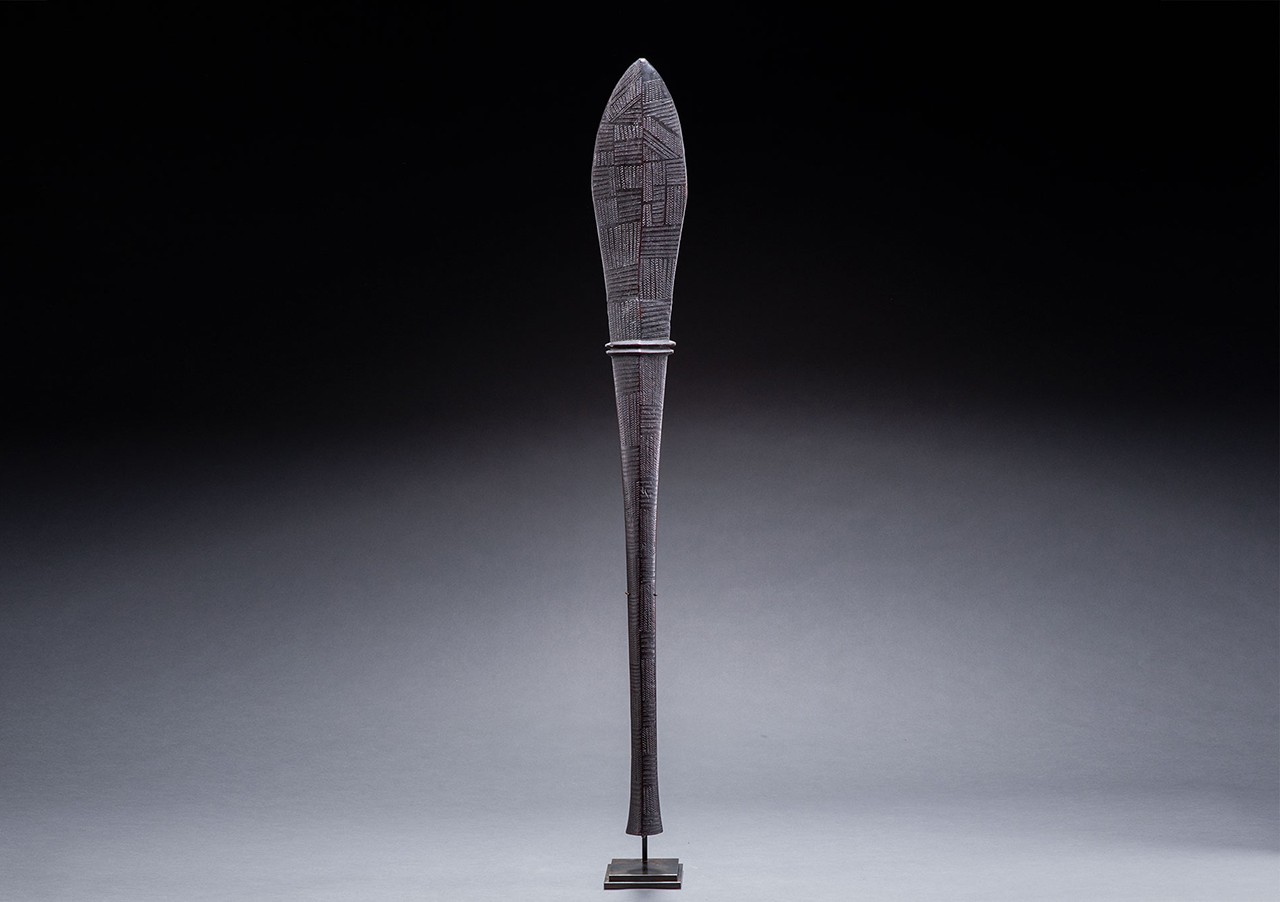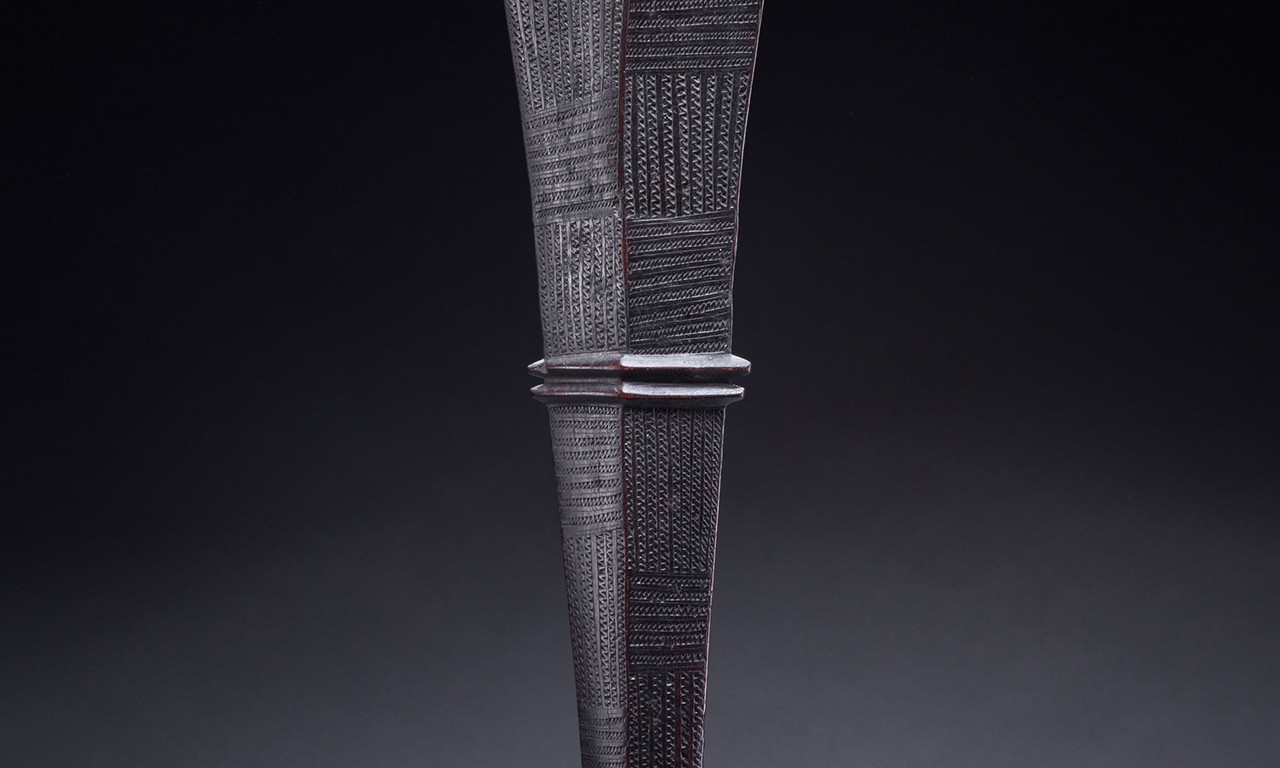© 2023 Kreativa. All rights reserved. Powered by JoomShaper
Two-Face: An Unfinished Tongan Paddle Club
 |
| Details of Paddle Club (Mougalaulau), mid 19th Century Tonga, Polynesia Wood; 45 ½ in. 2019.19.1 Bowers Museum Purchase; Photograph courtesy of Michael Hamson |
Endless Buffering
The towering spires of Antoni Gaudí’s Basilica de la Sagrada Familia, the fragmented narrative of F. Scott Fitzgerald’s The Love of the Last Tycoon or Michelangelo’s unfinished prisoners, sculptures which are eternally half-trapped in marble; not all great masterpieces are finished, and in some instances their lack of completion makes them more revelatory—and perhaps even more remarkable—than they would be as finished works. Today’s post looks at one of the Bowers Museum’s newest acquisitions, a never-completed carved wooden club from Tonga, exploring the larger context of Tongan clubs and then focusing on what the unfinished nature of this object can tell us.
The Friendly Islands
When Cook first visited the Tongan islands he called them the “Friendly Islands” because he did not see any fighting or even notice any weapons during his visit. There were two reasons behind this observation: the first is that during times of peace only the Tongan chiefly class could bear weapons; and the second, substantiated as well as it can be by Polynesia’s spotty late 18th Century historical record, is that there was a long period of peace in Tonga that was not broken until the death of a king and subsequent struggle for succession in 1777. Much of what was written about Tonga and the art of war comes from after that date. In the warring period of almost 40 years Tongan warriors came to be known—particularly by Fijians and Samoans who had borne the brunt of their war parties even prior to the civil war—as fierce combatants.
 |
| 2019.19.1 Bowers Museum Purchase; Photograph courtesy of Michael Hamson |
More Than One Way to Swing a Club
Several weapons were used by Tongans in warfare, but the primary one was the club. They were created in all shapes and sizes in Tonga, from short handheld or throwing clubs to immense two-handed spade-shaped clubs. There was a diversity of club heads in Tonga, the simplest of which simply broadened from the shaft, but could be complex, utilizing ribbing, small geometric projects or have a paddle-shaped head. This club falls nicely into that latter category and is called a Mougalaulau. It is well-characterised by the rounded paddle-shaped head seen here, as well as being covered by incisions and having at least one transverse rib. The usages of Tongan clubs were similarly varied. Certainly, throwing clubs and many of the mainstay weapons were only used in the formal warfare fought within Polynesia, but mock battles were also staged between Tongan fighters as a form of entertainment for chiefs. Lighter paddle clubs were used in dances, religious activities, and the most ornately carved examples were the everyday trappings of chiefs.
 |
| Detail of 2019.19.1 Bowers Museum Purchase; Photograph courtesy of Michael Hamson |
Figureless
While the introduction of Western metal tools to Oceania tended to lower the overall quality of woodcarvings throughout the region, they had the opposite effect for Tonga clubs up until their production slowed and then stopped almost altogether in the 1880s. Woodcarvers had traditionally used stone, bone and shark tooth tools to create shallow incisions in clubs, but the introduction of the nail allowed carvers to easily create much deeper incisions. The result is clubs that are entirely covered in layers of deep, geometric incisions, usually split into sections that either complimented or contrasted with those around them. Many Tongan clubs also have small representational carvings of animal or human figures worked in to these larger geometric patterns. This club happens to not feature any such motifs.
Unfinished but Nicely Patinated
Aside from being incredibly well carved, and with a rich patina, perhaps the most remarkable aspect of this club is that one of its sides is unfinished. Tongan clubs required incredible skill to carve and as a result were only made in workshops by master carvers. It is unclear why exactly this work was not finished, though there are any number of guesses including that the chiefly patron that this club was being carved for passed away or decided he no longer wanted it. What is most likely, however is that the carver passed away while working on it. The designs on the reverse of the club are already partly blocked out in a manner consistent with the fully-decorated side of the club, but the quality of the few carvings that are there is inconsistent with that of those of on the finished side, indicating that a less-skilled carver attempted to finish the work begun by a master carver. Whatever the reason, the work on the reverse was abandoned and the club now exists in its semi-compete state.
Text and images may be under copyright. Please contact Collection Department for permission to use. References are available on request. Information subject to change upon further research.

Comments